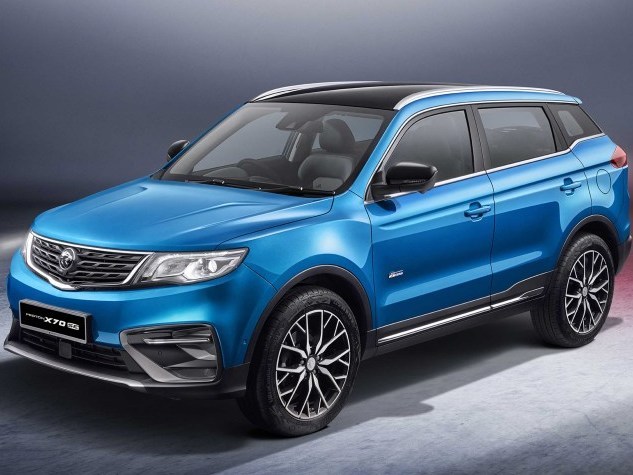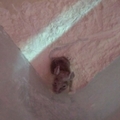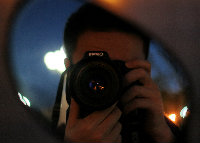Q
Does the Proton X70 Support Android Auto?
Yes, the Proton X70 does support the Android Auto feature. This configuration allows drivers to seamlessly connect their Android phones to the in - car infotainment system, enabling them to use applications such as navigation, music, and make calls, thereby enhancing driving convenience and safety. As the flagship SUV of a Malaysian local brand, the Proton X70 has always kept up with market demands in terms of technological configurations. Apart from Android Auto, some high - end models are also equipped with Apple CarPlay, voice control, and advanced driving assistance systems, providing users with a more intelligent driving experience.
It should be noted that when using Android Auto, you need to connect your phone via the original USB data cable and ensure that your phone's system version meets the requirements. If you encounter connection problems, it is recommended to check the quality of the cable or update your phone's system. You can also refer to the owner's manual or contact the Proton authorized service center for technical support.
For Malaysian consumers who value intelligent connectivity features, the Proton X70's such configurations offer good competitiveness among vehicles in the same class. Especially when combined with its local after - sales network and cost - effectiveness advantages, it is definitely worth considering.
Special Disclaimer: This content is published by users and does not represent the views or position of PCauto.
Related Q&A
Q
What is the spec of the Proton X70 2022?
The 2022 Proton X70, Malaysia's flagship homegrown SUV, offers two turbocharged petrol engine options: 1.5L TGDi and 1.8L TGDi. The 1.5L variant pumps out 177 hp and 255 Nm of torque, while the 1.8L ups the ante with 184 hp and 300 Nm. Both pair with a 7-speed dual-clutch transmission, and select models get an intelligent all-wheel-drive system.
Across the range, you'll find standard features like an 8-inch infotainment touchscreen with Apple CarPlay/Android Auto, keyless entry, and a power tailgate. Higher trims add extras such as a panoramic sunroof, NAVI navigation, and a premium sound system.
Safety is well-covered too, with 6 airbags, ESC stability control, 360-degree cameras, and automatic emergency braking (AEB) coming standard—ticking all the boxes for Malaysians after a high-value SUV.
What really stands out is the X70's intelligent AWD system, which automatically adjusts torque based on road conditions—pretty rare for this price bracket. Plus, connected car features like remote engine start and pre-cooling are total lifesavers in Malaysia's sweltering heat. These little touches show Proton gets local driving needs, keeping the X70 competitive in the B-segment SUV game.
Q
What are the common problems with the X70?
As a popular SUV in the Malaysian market, the Proton X70 has some common owner-reported issues. Some models may develop sunroof rattles or drain hole clogs after long-term use, which can usually be fixed with regular cleaning and lubrication. Additionally, early production batches occasionally experienced delays with electronic systems like the 360-degree panoramic camera, which most improved after software updates. For the 1.8TGDI turbo engine, carbon buildup needs attention at high mileage—follow the manual for maintenance and use qualified engine oil. It's worth noting the X70's sport-oriented suspension tuning can feel stiff on certain Malaysian road conditions, but this is a design choice, not a fault. For potential buyers, prioritize models with the latest ECU updates and regularly check transmission fluid to ensure smooth operation of the 7-speed dual-clutch gearbox. These preventive steps significantly enhance long-term ownership experience. Realistically, any vehicle may have specific maintenance needs under heavy use—the key is proper servicing through official channels and addressing minor issues promptly.
Q
What engine is in the X70 2021?
The 2021 Proton X70 is powered by a 1.8-liter TGDI four-cylinder turbocharged petrol engine, which cranks out 184 horsepower and a peak torque of 300 Nm. It's mated to a 7-speed dual-clutch transmission (DCT) and offers both front-wheel drive and all-wheel drive options. This engine, tech-sourced from Geely, uses direct fuel injection and turbocharging to strike a solid balance between performance and fuel efficiency, making it well-suited for Malaysia's diverse road conditions. What's nice is that the turbo engine delivers strong torque at low revs, so the X70 feels relaxed whether you're driving in the city or overtaking on the highway. For Malaysian buyers, maintenance costs for this engine are pretty reasonable, and Proton's after-sales service network covers the whole country, making it easy for owners to get their cars serviced or repaired. If you're curious about how turbocharging works, it basically uses exhaust gases to spin a turbine, which forces more air into the engine—this boosts efficiency, and you'll find this tech in lots of modern cars these days.
Q
Is the T60 Max a good car?
The Proton X70, Proton's first SUV developed in collaboration with Geely, has maintained steady performance in the Malaysian market. Built on Geely's Boyue platform, it's powered by a 1.8L turbocharged engine paired with a 6-speed automatic transmission, delivering smooth power delivery and fuel efficiency well-suited to local road conditions. The chassis tuning strikes a balance between urban driving comfort and light off-road capability.
In terms of interior features, higher-spec variants come equipped with a panoramic sunroof, large touchscreen display, and smart connectivity functions—catering perfectly to Malaysian consumers' preference for tech-forward amenities. Proton's extensive nationwide after-sales network also helps alleviate concerns about maintenance and ownership costs.
When compared to Japanese rivals in the same segment, the X70's key advantage lies in its stronger value proposition. However, buyers should note that its resale value retention tends to be slightly lower than established traditional brands.
Given Malaysia's rainy climate, regular checks on door seals and electronic systems are advisable. Additionally, the tropical heat places higher demands on the cooling systems of turbocharged vehicles—sticking to scheduled coolant replacements will help prolong engine life.
Overall, the X70 suits family buyers with a budget around RM150,000 who prioritize features and interior space. During test drives, pay special attention to how the dual-clutch transmission performs in stop-and-go traffic and assess the air-conditioning system's cooling efficiency.
Q
What is EPB malfunctions on Proton X70?
EPB malfunctions (Electronic Parking Brake System malfunctions) on the Proton X70 usually manifest as a warning light illuminating on the dashboard or the system failing to start/release properly. Common causes include the system triggering protection due to excessive brake pad wear, abnormal signals from electronic sensors, insufficient battery voltage affecting module power supply, or the need for software upgrade and reset. When encountering this problem, it is recommended to first try manually resetting by pressing the brake pedal firmly and pulling up the EPB switch for 3 seconds with the vehicle powered on. If it doesn't work, a professional diagnostic tool should be used to read the fault codes. Special attention should be paid to checking the thickness of the brake pads (replace them if they are less than 3mm) and the condition of the wiring connections.
As an electronic component, the EPB system relies more on the stability of the vehicle's overall electrical system than traditional handbrakes. Therefore, during regular maintenance, attention should be paid to checking the health of the battery (especially in hot climates), and long - term parking that may drain the battery should be avoided. The EPB system of the Proton X70 works in conjunction with the ESP Vehicle Stability System. If the malfunction persists, the Auto Hold function may fail. In this case, the authorized service center should be contacted promptly to avoid affecting driving safety.
The rainy and humid environment in Malaysia may accelerate the oxidation of the braking system. It is recommended to check the lubrication of the brake caliper guides every 20,000 kilometers, which is very helpful for maintaining the sensitivity of the EPB actuator.
Q
How many cc is a Proton x70 engine?
The Proton X70 comes with two engine displacement options: a 1.5-liter turbocharged (1498cc) and a 1.8-liter turbocharged (1798cc), depending on the vehicle configuration. The 1.5T version uses direct injection technology, with a maximum horsepower of 177hp and a peak torque of 255Nm. The 1.8T version offers 184hp and 300Nm of torque. Both are paired with a 7-speed dual-clutch transmission.
As the main SUV of a Malaysian local brand, the Proton X70's engine technology is derived from the power platform jointly developed by Geely and Volvo. It balances fuel economy and power performance, making it suitable for Malaysia's diverse road conditions. The turbocharged engine can deliver high torque at low RPMs, which is especially suitable for city driving and climbing mountain roads. The direct injection technology can improve combustion efficiency and reduce fuel consumption.
It's worth noting that engine displacement (cc) doesn't directly equal power output. Other factors such as turbocharging and transmission tuning also need to be considered. That's why the 1.5T engine of the Proton X70 can rival the performance of a traditional 2.0-liter naturally aspirated engine.
Q
How to use cruise control Proton X70?
Using the cruise control function of the Proton X70 is extremely simple. First, make sure the vehicle is traveling at a speed of over 40 km/h. Then, press the cruise control button on the left side of the steering wheel to activate the system. At this time, the cruise control symbol will appear on the dashboard. Next, use the "+" or "-" buttons to set the desired speed. After setting, release the accelerator pedal, and the vehicle will maintain a constant speed. If you need to temporarily cancel the cruise control, gently tap the brake or press the cancel button. To turn it off completely, press the main cruise control button again.
It's worth noting that the cruise control system of the Proton X70 may automatically adjust the throttle on steep slopes to maintain the set speed. This is a normal phenomenon. Additionally, extra caution is required when using this system on rainy or slippery roads. It is recommended to keep a greater safety distance. The cruise control function is most suitable for long - distance driving on highways or other roads with good conditions, which can effectively reduce driving fatigue. However, drivers still need to stay focused and be ready to take over vehicle control at any time, as the system cannot recognize sudden obstacles or complex road conditions.
There may be slight differences in the cruise control details of Proton X70s from different years. It is recommended that owners also refer to the user manual that comes with the vehicle for specific operation instructions.
Q
What is boss seat switch Proton X70?
The Boss seat switch is a convenient feature of the Proton X70. It's mainly installed on the side of the front passenger seat, allowing rear - seat passengers (especially those in the "boss seat" on the right rear) to directly adjust the front - passenger seat's forward and backward position and backrest angle. This helps to increase legroom and enhance seating comfort. This design is commonly seen in mid - to high - end SUVs, highlighting the X70's practicality for business use.
As one of the most popular SUVs locally, the Proton X70's Boss seat switch is easy to operate. You just need to press the switch and move the seat to make adjustments, without having to bend over or exert much effort. It's especially suitable for family outings or business receptions.
Apart from this feature, the X70 also comes with luxury configurations such as a panoramic sunroof and Nappa leather seats. Its overall cost - effectiveness is quite competitive in the Malaysian market. It is recommended that car owners clean the switch contacts regularly to prevent dust from affecting the sensitivity. At the same time, refer to the user manual to understand the specific operation details. This kind of user - friendly design also reflects Proton's careful consideration of user needs.
Q
Does the Proton X70 Support remote start?
Yes, the Proton X70 is indeed equipped with a Remote Start function. This feature can be operated via the smart key or a mobile app (such as the Proton Link App), allowing the owner to start the engine from a distance and turn on the air - conditioning system in advance. It's especially practical in Malaysia's hot weather. The Remote Start usually needs to be used within a certain effective range, and the vehicle must be in a locked state to ensure safety.
Apart from the Remote Start, the Proton X70 also comes with other intelligent technology configurations, like keyless entry, automatic air - conditioning, and an advanced infotainment system, which further enhance driving convenience and comfort. It should be noted that when using the Remote Start, it is recommended to ensure that the vehicle is parked in a well - ventilated area to avoid unnecessary fuel consumption or emission problems caused by long - term idling.
As a popular local SUV, the Proton X70's technological configuration and practical design fully take into account the needs of Malaysian users, providing more convenient options for daily use.
Q
What is the crash rating of the Proton X70?
The Proton X70 has achieved a 5-star rating in the ASEAN NCAP crash safety test, which is the highest safety level in this testing system. This indicates that it performs excellently in adult occupant protection, child occupant protection, and safety assistance technologies. Specifically, the Proton X70 demonstrated good occupant protection capabilities in both frontal and side impact tests. The use of its body structure and high-strength steel effectively absorbed the collision energy. Meanwhile, it comes standard with safety features such as six airbags, Electronic Stability Control (ESC), and Anti-lock Braking System (ABS), which further enhance its safety. For Malaysian consumers, the ASEAN NCAP rating is an important reference standard because it is specifically optimized for the road conditions and driving environments in Southeast Asia. Compared with other global rating systems like Euro NCAP or IIHS, it is closer to the local actual needs. Additionally, the Proton X70 is also equipped with advanced driver assistance systems such as Autonomous Emergency Braking (AEB) and Lane Keeping Assist (LKA). These functions can effectively reduce the risk of accidents in daily driving. Choosing a vehicle with a high safety rating can not only protect the passengers but also ensure better resale value in the used car market. Therefore, the 5-star rating of the Proton X70 is one of its significant advantages.
Popular Cars
Model Year
Car Compare
Car Photo
Latest Q&A
Q
Is a 3.0 liter engine a V6?
A 3.0-liter engine doesn’t always mean a V6 configuration—though V6 is indeed the most common layout for this displacement. The actual engine type depends on the vehicle’s design. For example, some BMW models use an inline-six, while certain Porsches feature a flat-six, both in 3.0-liter form. Even some V8s can achieve a 3.0-liter working volume with cylinder deactivation.
The relationship between displacement and cylinder count boils down to individual cylinder capacity and layout. A typical 3.0L V6 averages around 500cc per cylinder, striking a balance between power delivery and smoothness.
Worth noting: Turbocharging has blurred the lines—smaller engines (like high-output 2.0T units) now match the power of naturally aspirated 3.0Ls. When evaluating engines, don’t just fixate on displacement or cylinder count. Factor in tech like direct injection and variable valve timing—brands tune even identical displacements differently. Some prioritize low-end torque for city driving, while others favor high-revving performance for highway cruising.
Q
What is the difference between a 2.4 L and a 3.0 L engine?
The key difference between 2.4L and 3.0L engines boils down to displacement. The 3.0L's larger cylinder volume means it gulps more air and fuel per combustion cycle, delivering roughly 20-30% more horsepower and torque than the 2.4L – perfect for drivers who prioritize acceleration or towing capability.
That said, the 2.4L shines in fuel efficiency, especially for city driving. Both engines might pack modern tech like variable valve timing or direct injection, but 3.0L variants often get extra performance goodies—think twin-scroll turbos or high-pressure fuel systems.
Just remember: bigger displacement typically means higher road taxes and running costs. Many models offer both options, so choose based on your needs—whether it's power or pocket-friendly mileage.
Q
Is the 3.5 EcoBoost a V6 or V8?
Ford's 3.5L EcoBoost is a twin-turbocharged V6 engine—not a V8 configuration. It combines direct injection and turbocharging tech to deliver near-V8 power from a more compact six-cylinder package. Typical versions punch out around 375 horsepower and 475 Nm of torque, commonly found in F-150 pickups and Explorers. The real win here is balancing performance with decent fuel efficiency.
The core difference between V6 and V8 layouts boils down to cylinder count and refinement—V8s traditionally offer smoother power delivery and higher peak output, but at the cost of added weight and thirst. Modern turbo V6s like this EcoBoost have narrowed that gap significantly. It’s Ford’s poster child for giving buyers the best of both worlds: robust towing capability without the daily-driver penalties of a bulkier V8. If you want American muscle without guzzling fuel or wrestling with a ponderous rig around town, these force-fed six-cylinders hit the sweet spot.
Q
What does 2.4 L I4 mean?
The 2.4L I4 refers to a 2.4-liter displacement engine with an inline-four cylinder layout—a common configuration found in many vehicles. The 2.4L displacement means the total volume of all cylinders adds up to 2.4 liters, and generally, a larger displacement delivers stronger power output, making it suitable for performance-oriented driving. The inline-four design is popular for its compact size and fuel efficiency, striking a good balance between smoothness and noise control while keeping maintenance costs reasonable for daily use. Some models may even pair this engine with turbocharging for extra power and efficiency. If you prioritize fuel economy and reliability without sacrificing everyday usability, the 2.4L I4 is a solid choice, whether for city commutes or long-distance trips.
Q
Which engine is better, V6 or V8?
V6 and V8 engines each have their pros and cons—it really comes down to your needs and how you plan to use them. A V6 is generally lighter, more fuel-efficient, and easier on the wallet for maintenance, making it a solid pick for daily commuting or city driving. On the other hand, a V8 delivers more power and smoother performance, ideal for high-performance cars or heavy towing, though it guzzles more fuel and costs more to maintain.
In hot, rainy climates, V6s tend to handle heat better, while V8s offer more stability at high speeds. These days, turbocharged V6s are closing the performance gap with traditional V8s, though V8s still dominate in luxury and sports models.
Whichever you choose, sticking to regular maintenance and using the right oil viscosity is key to keeping your engine healthy. Just weigh your driving habits and budget—there’s no one-size-fits-all answer.
View MoreRelated News

Proton X70 interior design fully revealed: Suitable for both home and business use
JohnJul 7, 2025

Space, Interior & Power: How Does the Proton X70 Excel in Every Aspect?
WilliamApr 14, 2025

How large is the boot space of the Proton X70? How does it compare with other cars?
MichaelMar 3, 2025

What is the fuel consumption of X70? Is X70 a worthwhile SUV to buy?
RobertFeb 27, 2025

Equipped with a 1.5T engine, a maximum horsepower of 177Ps, is the Proton X70 suitable for home use?
MichaelSep 26, 2024
View More

















Pros
Cons